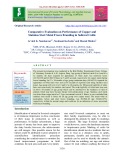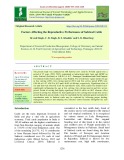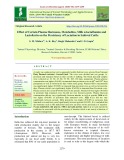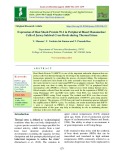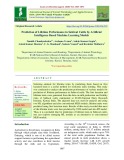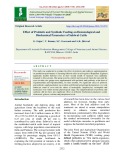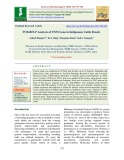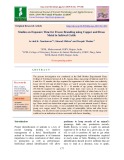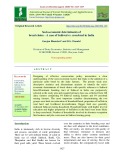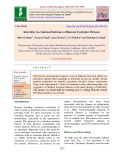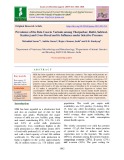
Sahiwal cattle
-
The present investigation was conducted at the Bull Mother Experimental Farm, College of Veterinary Science & A.H., Anjora, Durg. Age group of Sahiwal cattle 0 to 6 and 6 to 12 months, the days required for appearance of white hairs was relatively lesser (43.33±1.20 and 42.8±4.93 days) at 7 and 8 seconds, respectively for copper metal during freeze branding. In 12 – 18 months of age group, minimum days (49.8±7.15) required for appearance of white hairs were seen at 18 seconds of exposure time using stainless steel metal.
 9p
9p  nguaconbaynhay10
nguaconbaynhay10
 22-01-2021
22-01-2021
 6
6
 1
1
 Download
Download
-
The present study was conducted on 308 Sahiwal cows sired by 38 bulls spared over a period of 32 years (1981- 2012), maintained at instructional dairy farm and AICRP on cattle -Sahiwal (field unit) at G.B.P.U.A. & T., Pantnagar Uttarakhand and Chak Ganjaria Government Cattle Farm Lucknow, Uttar Pradesh.
 5p
5p  trinhthamhodang1216
trinhthamhodang1216
 19-11-2020
19-11-2020
 7
7
 2
2
 Download
Download
-
A study was conducted on twelve apparently healthy Sahiwal cows selected from National Dairy Research institute’s livestock herd. The cows were divided into two groups i.e. persistent and truncated based on their records of milking.
 12p
12p  caygaocaolon7
caygaocaolon7
 18-09-2020
18-09-2020
 16
16
 2
2
 Download
Download
-
Heat Shock Protein 70 (HSP70) is one of the important molecular chaperon that can protect cells from thermal damage by involving in the maintenance of the intra cellular homeostasis primarily by controlling the process of protein folding. The indigenous breeds of cattle have been found to be more resistant to heat stress in comparison to the exotic breeds by way of expressing HSP70 as an adaptive response.
 9p
9p  nguaconbaynhay7
nguaconbaynhay7
 15-08-2020
15-08-2020
 12
12
 1
1
 Download
Download
-
Selecting animals for lifetime traits by predicting them based on first lactation traits is a useful method for economic dairy farming. This study was conducted to analyze the prediction performance of various models for prediction of lifetime performance in Sahiwal cattle. The first lactation and lifetime traits were generated from the data on milk production and fertility traits of Sahiwal cattle maintained at ICAR-National Dairy Research Institute, Karnal, India.
 7p
7p  angicungduoc6
angicungduoc6
 22-07-2020
22-07-2020
 7
7
 1
1
 Download
Download
-
The physiological responses, dry matter and water intake of Sahiwal and Karan Fries (Holstein-Friesian X Tharparkar) heifers were monitored under two feeding regimes i.e. feeding regime-1 (NRC, 2001) and feeding regime-2 (15 % higher energy than NRC 2001, by supplementation of molasses). Six each of healthy heifers of Sahiwal and Karan Fries (18-24 month) were selected from ICAR-National Dairy Research Institute (ICAR-NDRI), Karnal. Before start of actual experiment, the animals were given 15 days adaptation period on both the feeding regime.
 9p
9p  nguaconbaynhay6
nguaconbaynhay6
 24-06-2020
24-06-2020
 10
10
 0
0
 Download
Download
-
An experiment was conducted to investigate the effect of vitamin E and Chromium propionate during transition period in Sahiwal cows to assess the possibilities of improvement in production performance of supplementation of vitamin E and Chromium propionate. A total of 28 cows were selected on the basis of their milk yield, parity and body weight are grouped into four homogenous treatment groups of 7 each. No significant effect of supplementation was seen on milk composition.
 6p
6p  quenchua6
quenchua6
 15-06-2020
15-06-2020
 11
11
 3
3
 Download
Download
-
This study was conducted to evaluate the effect of probiotic and synbiotic supplementation on production performance of lactating Sahiwal cattle in arid region of Rajasthan. Eighteen apparently healthy Sahiwal cows in their second month of lactation were randomly assigned to three groups. One group acted as control and was given basal diet only and the cows in other two groups were supplemented with probiotic and synbiotic at the dose of 15g/animal/day and 10g/animal/day, for three months.
 9p
9p  angicungduoc5
angicungduoc5
 12-06-2020
12-06-2020
 14
14
 2
2
 Download
Download
-
Present study was conducted on 50 bulls and 40 male calves of Sahiwal, Tharparkar and Karan Fries cattle maintained at Artificial Breeding Research Center and Livestock Research Center, NDRI Karnal (Haryana) to identify genetic polymorphisms in TNP2 gene.
 8p
8p  cothumenhmong5
cothumenhmong5
 17-05-2020
17-05-2020
 11
11
 1
1
 Download
Download
-
The present investigation was conducted at the Bull Mother Experimental Farm, College of Veterinary Science & A.H., Anjora, Durg. Age group of Sahiwal cattle 0 to 6 and 6 to 12 months, the days required for appearance of white hairs was relatively lesser (43.33±1.20 and 42.8±4.93 days) at 7 and 8 seconds, respectively for copper metal during freeze branding.
 10p
10p  nguaconbaynhay4
nguaconbaynhay4
 22-03-2020
22-03-2020
 8
8
 1
1
 Download
Download
-
Designing of effective conservation policy necessitates a clear understanding of the socio-economic factors that leads to the adoption of a particular cattle breed by the dairy farmers. The present study uses descriptive statistics and discriminant analysis to identify the socioeconomic determinants of breed choice with specific reference to Sahiwal breed.Prominent breeding tract of Sahiwal in India was purposively selected as the study area and required primary data was collected from 168 dairy farmers comprising 84 Sahiwal rearing farmers and 84 crossbred rearing farmers.
 11p
11p  nguaconbaynhay3
nguaconbaynhay3
 07-02-2020
07-02-2020
 16
16
 0
0
 Download
Download
-
The present communication reports a case of Sahiwal cattle bull which was presented with the chief complaint of infertility for last six months. Semen analysis performed on periodic ejaculates revealed watery consistency along with oligospermia. Critical examination using ultrasonography was suggestive of bilateral testicular fibrosis as the chief etiology of infertility. The animal was found unfit for breeding and it’s culling from the routine breeding programs was advised.
 4p
4p  nguathienthan2
nguathienthan2
 25-12-2019
25-12-2019
 8
8
 0
0
 Download
Download
-
Milk has been regarded as wholesome food since centuries. The major milk proteins are the casein (80%) and the whey proteins (10%). One of the prominent milk proteins in cattle i.e. beta casein, is encoded by highly polymorphic genes, leading to formation of 12 protein variants. Among them A1 and A2 variant are the most frequent; the A2 being the primitive type present in Bos indicus at higher percentage than Bos taurus.
 7p
7p  kequaidan2
kequaidan2
 13-12-2019
13-12-2019
 13
13
 0
0
 Download
Download
CHỦ ĐỀ BẠN MUỐN TÌM









